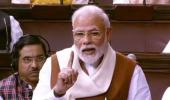'More a show that you are doing something in the Budget, even if that something never actually comes to pass,' notes Nitin Desai.

When Nirmala Sitharaman presented the government's Budget for the current fiscal year in July 2019, this columnist had argued: 'The revenue projections are unrealistic.... The real deficit is more likely to be closer to 4 per cent than the 3.3 per cent indicated in the Budget.'
The finance minister's Budget admission that the official figure for the deficit is 3.8 per cent vindicates that fear.
The projected tax revenue in 2019-2020 is Rs 18.50 trillion as against the Budget estimate of Rs 19.63 trillion, a fall of 5.6 per cent, which is less than what the available actuals up to December suggest.
The 2019-2020 expenditure number reported by the FM is Rs 26.99 trillion, which compared to the Budget figure of Rs 27.86 trillion, is about 3.1 per cent lower.
In fact, the actual outcome may be even worse as the present estimate is based on guesswork about tax collections in the last two months of the year.
But, of course, they always have the option of hiding the facts by postponing payments and pushing the payment burden onto entities like the Food Corporation of India.
If you see Statement 27 in the Expenditure profile of the Budget, you can see that the extra-budgetary and other resources mobilised for budgetary outlays have gone up from Rs 88,000 crore in 2017-2018 to Rs 1.62 trillion in 2018-2019, Rs 1.73 trillion in 2019-2020 and are expected to go up to Rs 1.86 trillion in 2020-2021.
When it comes to the year ahead, the Budget projects an increase in tax revenue of 9 per cent, which with the projected nominal gross domestic product growth of 10 per cent implies a tax elasticity of under one.
If the base figure for 2019-2020 revenues turns out to be even lower than what the Budget speech indicated, then this elasticity number will be higher.
For comparison, the average tax elasticity for the decade ending 2017-2018, for which we have final numbers, was one 0.8.
The projected increase in market borrowings relative to the revised estimates for 2019-2020 is a modest 4 per cent.
But this is because there is a big jump in other capital receipts, mainly from asset sale, from Rs 65,000 crore to Rs 2.1 trillion.
Since this will also draw on private savings, the increase in the government's demands on the capital market will actually rise by 21 per cent.
Incidentally, the other capital receipts item shows a serious shortfall in 2019-2020 with an expected realisation of Rs 65,000 crore against the budgeted Rs 1.05 trillion.
The overall conclusion is that the macroeconomics of this Budget needs closer scrutiny.
We may well end up with the same budgetary mess that we have experienced this year.
When it comes to policy innovations, this is a Budget that will probably disappoint all other than some middle-class taxpayers -- who will welcome the tax rate reductions -- and foreign investors.
On the growth booster side, the ambitious provision for infrastructure project finance and the moves to deepen bond markets may help to turn around the economy in the longer term.
The step backward from trade liberalisation with the increase in customs duties to protect domestic manufacturers will please some but be harmful in the longer run as it will delay the goal of making Indian industry globally competitive.
The rationalisation of exemptions and deductions in the personal income tax is a move in the right direction.
There are some helpful provisions in the Budget to reduce harassment by tax authorities and the company law administration.
Hopefully, the proposed taxpayer's charter will be drafted to give true expression to this intent.
There are other measures to simplify things for taxpayers, such as the increase in the compulsory audit limit from Rs 1 crore to Rs 5 crore and the option given to employee stock ownership plan holders in the timing of their tax liability.
On the expenditure side every year the Budget presents a long list of development initiatives in Part A.
This year's Part A of the speech was quite elaborate on the populist vote winning ideas but rather more cursory on the measures to boost investment.
When these supposed new initiatives are presented, there is little reference to what they will replace and how they fit into the relevant policy framework.
For instance, there is the announcement of making every district an export hub.
How is this to be done if factors like exchange rates, bottlenecks in tax refund procedures and poor logistics that determine export incentives remain as they are.
Moreover, is the goal of every district as an export hub consistent with the fact that the economies of agglomeration that come from geographic concentration are even more vital for export producers who have to continually struggle to remain cost competitive? Every district as an export hub is a populist slogan that is this government's typical approach to economic policy.
We need a policy that will boost exports.
But it must be a policy that focuses on the fundamentals that determine export profitability.
Investors and the market were expecting much more from this Budget than what it has offered.
It does not look like a 'do or die' Budget, more a show that you are doing something in the Budget, even if that something never actually comes to pass.












 © 2025
© 2025